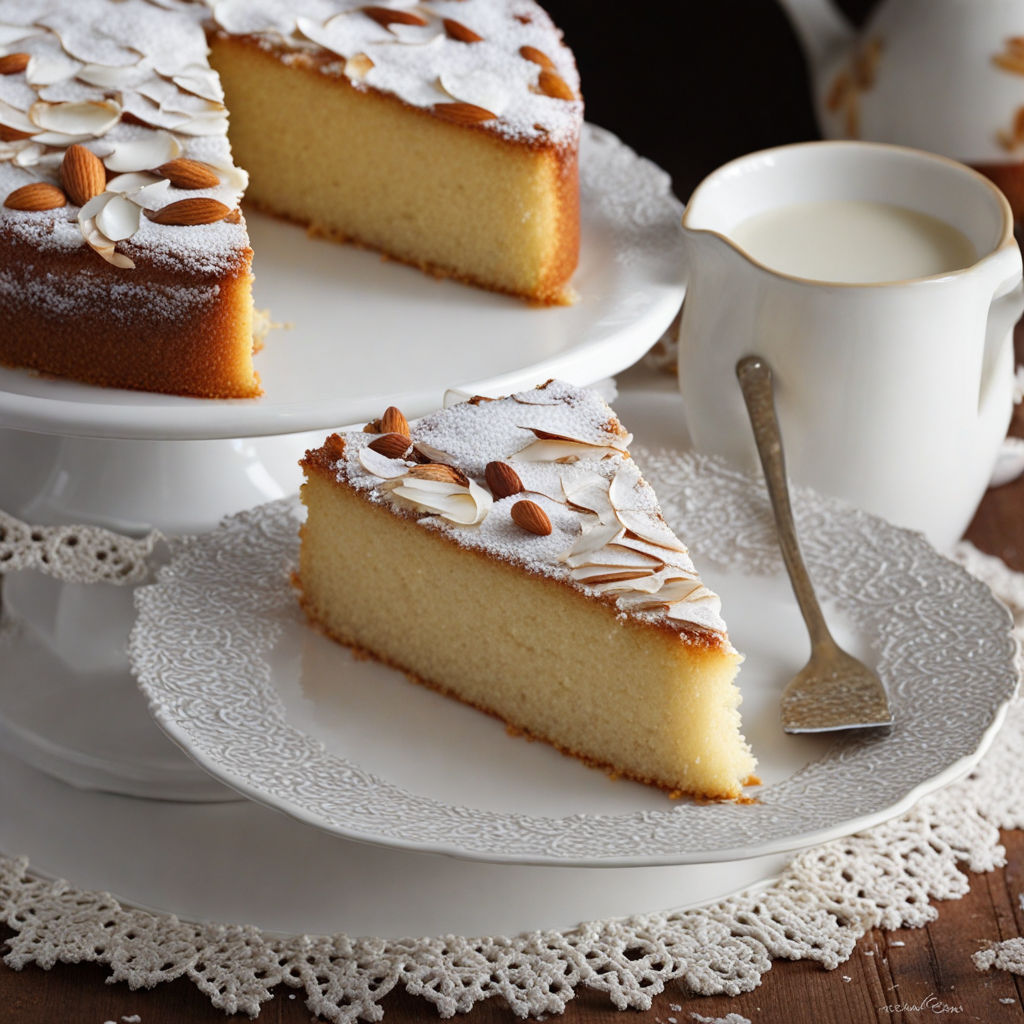Swedish Almond Cake
Swedish Almond Cake, known as "Toscakaka," is a delightful dessert that beautifully combines the nutty flavor of almonds with a moist, buttery cake base. This cake is typically made with ground almonds, which impart a rich, nutty taste and a tender crumb. The addition of almond extract enhances the flavor, giving each bite a fragrant aroma that is both comforting and inviting. Often, a hint of vanilla is incorporated as well, rounding out the flavors and adding depth to the overall profile of the cake. One of the standout features of Swedish Almond Cake is its unique topping. Once the cake has baked to golden perfection, it is crowned with a decadent layer of caramelized almond topping. This is achieved by simmering butter, sugar, and cream together, then folding in sliced or slivered almonds. The mixture is spread over the cake and returned to the oven, where it transforms into a crunchy, sweet layer that contrasts beautifully with the soft cake beneath. This combination of textures makes each bite a delightful experience. Served warm or at room temperature, Swedish Almond Cake is often enjoyed with a dusting of powdered sugar or a dollop of whipped cream. It pairs wonderfully with a cup of coffee or tea, making it a perfect treat for afternoon gatherings or special occasions. The cake's simplicity and elegance embody the Scandinavian ethos of using high-quality ingredients to create comforting and satisfying desserts, inviting anyone to savor the unique taste of Sweden.
How It Became This Dish
Mandeltårta: A Delicious Slice of Swedish History Mandeltårta, or almond cake, is a beloved dessert that holds a cherished place in Swedish culinary tradition. With its delicate flavors, rich textures, and cultural significance, this cake tells a story that weaves through the threads of Swedish history, geography, and social customs. The journey of Mandeltårta is not just about food; it reflects the evolution of Swedish society, the country's agricultural practices, and its deep-rooted appreciation for craftsmanship in baking. Origins: A Nutty Beginning The origins of Mandeltårta can be traced back to the late Middle Ages, a time when almonds, a luxury ingredient, were introduced to the Nordic countries through trade routes connecting Europe and the East. Almonds were highly prized for their versatility and rich flavor, making them a desirable addition to cakes and pastries. Sweden, with its expansive trade networks, began to incorporate almonds into its culinary repertoire, leading to the development of various almond-based desserts. The earliest forms of Mandeltårta may have been simple nut cakes made with ground almonds, honey, and eggs. These cakes often served as celebratory dishes during festivals and special occasions, highlighting the importance of almonds in Swedish society. The cake's evolution into the more refined Mandeltårta we recognize today was influenced by the changing tastes of the Swedish elite, who sought to create desserts that reflected their wealth and sophistication. Cultural Significance: A Symbol of Celebration Mandeltårta gained prominence as a celebratory dessert, particularly during important life events such as weddings, birthdays, and holidays. The cake is often adorned with marzipan decorations, giving it an aesthetic appeal that enhances its status as a centerpiece for festive gatherings. Traditionally, it is served during special occasions such as Christmas, where it competes with other holiday treats like gingerbread and saffron buns. In Swedish culture, food is not only about sustenance; it is also a way of bringing people together. Sharing Mandeltårta with family and friends is an expression of love and hospitality. The cake has become a staple at "fika," the cherished Swedish coffee break, where friends and colleagues gather to enjoy coffee and cake. This cultural practice of taking a break to enjoy a sweet treat promotes social interaction and strengthens community bonds. Development Over Time: From Tradition to Modernity As Sweden moved into the 18th and 19th centuries, culinary practices began to evolve. The introduction of new baking techniques and ingredients, such as refined sugar and butter, allowed for the development of more complex variations of Mandeltårta. The cake began to take on a more sophisticated form, often layered and filled with cream or fruit preserves, showcasing the artistry of Swedish bakers. In the 19th century, the popularity of Mandeltårta soared, coinciding with the rise of the middle class in Sweden. As more households gained access to ingredients and baking tools, the cake became a staple in homes across the country. Cookbooks began to feature Mandeltårta as a recipe, solidifying its place in Swedish culinary literature. One notable cookbook, "Svenska Kokboken" (Swedish Cookbook), published in the late 19th century, included a recipe for Mandeltårta that emphasized the use of quality ingredients and meticulous preparation. The 20th century saw further innovations in the preparation and presentation of Mandeltårta. Bakers experimented with flavors, incorporating chocolate, vanilla, and citrus zest to create unique variations of the traditional cake. The rise of tourism in Sweden led to an increased interest in regional specialties, and Mandeltårta became a sought-after treat in cafes and restaurants, often served alongside other Swedish delicacies. Contemporary Interpretations: A Cake for All Seasons In the modern era, Mandeltårta continues to evolve while maintaining its traditional roots. Contemporary Swedish bakers are experimenting with gluten-free and vegan adaptations of the cake, catering to diverse dietary preferences and health consciousness. This evolution reflects a broader trend in the culinary world, where traditional dishes are being reimagined to align with modern lifestyles. Mandeltårta is now more than just a cake; it has become a symbol of Swedish identity and pride. It is often featured in food festivals and competitions, showcasing the skills of bakers and the significance of regional ingredients. The celebration of Mandeltårta as part of Swedish cultural heritage has also gained international recognition, with Swedish expatriates and food enthusiasts around the world seeking to recreate this delightful dessert in their own homes. Conclusion: A Sweet Legacy Mandeltårta is more than just a delicious almond cake; it is a testament to Sweden's rich culinary history and cultural heritage. From its humble beginnings as a simple nut cake to its status as a centerpiece of celebration and community, Mandeltårta has endured through the centuries, adapting to changing tastes and societal shifts. As we enjoy a slice of this delightful dessert, we partake in a tradition that connects us to the past, reminds us of the importance of community, and celebrates the artistry of Swedish baking. Whether shared during a festive gathering or enjoyed during a quiet fika, Mandeltårta remains a sweet legacy that continues to bring joy to the table, embodying the spirit of Sweden in every bite.
You may like
Discover local flavors from Sweden







